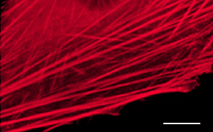
|
||||||||||
|
||||||||||

|
|
||||||||||||||||||||||||||||||||||||||||||||||||||||||
The vector sequence has been compiled using the information from sequence databases, published literature, and other sources, together with partial sequences obtained by Evrogen. This vector has not been completely sequenced. |
|||||||||||||||||||||||||||||||||||||||||||||||||
 Download
|
| ||||||||||||||||||||||||||||||||||||||||||||||||
Vector description
pmKate2-actin is a mammalian expression vector encoding mKate2-actin fusion protein (see reporter description). The vector can be used for fluorescent labeling of
 | Transiently transfected fox lung fibroblast cells (FoLu) expressing mKate2 fusion with human |
mKate2 codon usage is optimized for high expression in mammalian cells (humanized) [Haas et al., 1996]. Human cytoplasmic
pmKate2-actin vector can be used as a source of mKate2-actin hybrid sequence. The vector backbone contains unique restriction sites that permit its excision and further insertion into expression vector of choice.
Note: The plasmid DNA was isolated from dam+-methylated
The vector backbone contains immediate early promoter of cytomegalovirus (PCMV IE) for protein expression, SV40 origin for replication in mammalian cells expressing SV40 T-antigen, pUC origin of replication for propagation in
SV40 early promoter (PSV40) provides neomycin resistance gene (Neor) expression to select stably transfected eukaryotic cells using G418. Bacterial promoter (P) provides kanamycin resistance gene expression (Kanr) in
Expression in mammalian cells
pmKate2-actin vector can be transfected into mammalian cells by any known transfection method. CMV promoter provides strong, constitutive expression of the mKate2-actin fusion in eukaryotic cells. If required, stable transformants can be selected using G418 [Gorman, 1985].
Propagation in
Suitable host strains for propagation in
Location of features
PCMV IE: 1-589
Enhancer region: 59-465
TATA box: 554-560
Transcription start point: 583
Kozak consensus translation initiation site: 606-616
mKate2
Start codon (ATG): 613-615
Last amino acid in mKate2: 1306-1308
Beta-Actin: 1342-2469
Stop codon: 2467-2469
SV40 early mRNA polyadenylation signal
Polyadenylation signals: 2630-2635 & 2659-2664
mRNA 3' ends: 2668 & 2680
f1 single-strand DNA origin: 2727-3182
Bacterial promoter for expression of Kanr gene
-35 region: 3244-3249
-10 region: 3267-3272
Transcription start point: 3279
SV40 origin of replication: 3523-3658
SV40 early promoter
Enhancer (72-bp tandem repeats): 3356-3427 & 3428-3499
21-bp repeats: 3503-3523, 3524-3544 & 3546-3566
Early promoter element: 3579-3585
Major transcription start points: 3575, 3613, 3619 & 3624
Kanamycin/neomycin resistance gene
Neomycin phosphotransferase coding sequences:
Start codon (ATG): 3707-3709
Stop codon: 4499-4501
G->A mutation to remove Pst I site: 3889
C->A (Arg to Ser) mutation to remove BssH II site: 4235
Herpes simplex virus (HSV) thymidine kinase (TK) polyadenylation signal
Polyadenylation signals: 4737-4742 & 4750-4755
pUC plasmid replication origin: 5086-5729
References:
- Gorman C. High efficiency gene transfer into mammalian cells. In DNA cloning: A Practical Approach, Vol. II. Ed. D. M. Glover. (IRL Press, Oxford, U.K.). 1985; 143-90.
- Haas J, Park EC, Seed B. Codon usage limitation in the expression of HIV-1 envelope glycoprotein. Curr Biol. 1996; 6 (3):315-24. / pmid: 8805248
- Kozak M. An analysis of 5'-noncoding sequences from 699 vertebrate messenger RNAs. Nucleic Acids Res. 1987; 15 (20):8125-48. / pmid: 3313277
- Shcherbo D, Murphy CS, Ermakova GV, Solovieva EA, Chepurnykh TV, Shcheglov AS, Verkhusha VV, Pletnev VZ, Hazelwood KL, Roche PM, Lukyanov S, Zaraisky AG, Davidson MW, Chudakov DM. Far-red fluorescent tags for protein imaging in living tissues. Biochem J. 2009; 418 (3):567-74. doi: 10.1042/BJ20081949 / pmid: 19143658
Notice to Purchaser:
mKate2-related materials (also referred to as "Products") are intended for research use only. The Products are covered by U.S. Pat. 7,638,615; European Pat. 1994149; and other Evrogen Patents and/or Patent applications pending. By use of these Products, you accept the terms and conditions of the applicable Limited Use Label License.
|
Copyright 2002-2023 Evrogen. All rights reserved. Evrogen JSC, 16/10 Miklukho-Maklaya str., Moscow, Russia, Tel +7(495)988-4084, Fax +7(495)988-4085, e-mail:evrogen@evrogen.com |


